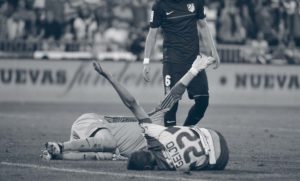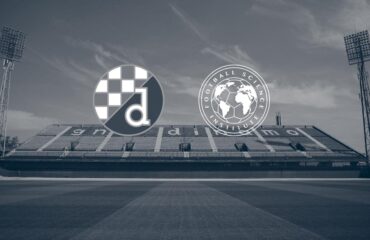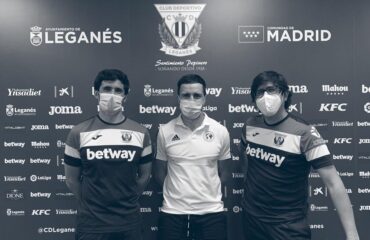1. Drill design using the ‘control-chaos continuum’: Blending science and art during return to sport following knee injury in elite football.
Allen T, Wilson S, Cohen DD, Taberner M.
Arsenal Performance and Research Team, Arsenal Football Club, London, UK; Institute of Coaching and Performance, University of Central Lancashire, Preston, UK. Electronic address: toallen@arsenal.co.uk.
The ‘control-chaos continuum’ (CCC) is an adaptable framework for on-pitch rehabilitation moving from high control to high chaos, progressively increasing running load demands and incorporating greater perceptual and neurocognitive challenges within sport-specific drills. This paper showcase drill progression through the phases of the CCC and provide recommendations to help practitioners create training session contents within the CCC concept.
Phys Ther Sport. 2021 Feb 24;50:22-35. doi: 10.1016/j.ptsp.2021.02.011. Online ahead of print.
2. Biceps Femoris Compensates for Semitendinosus After Anterior Cruciate Ligament Reconstruction With a Hamstring Autograft: A Muscle Functional Magnetic Resonance Imaging Study in Male Soccer Players.
Tampere T, Victor J(1), Luyckx T, Vermue H, Arnout N, Witvrouw E, Schuermans J.
Department of Orthopaedic Surgery, Ghent University Hospital, Ghent University, Faculty of Medicine and Health Sciences, Ghent, Belgium.
This study in 30 male soccer players cleared for RTP after ACL Reconstruction (ACLR) with medial hamstrings tendons including semitendinosus (ST) tendon harvest, and 30 healthy controls using functional magnetic resonance imaging after eccentric hamstring loading tasks, shows that significantly higher exercise-related activity was observed in the biceps femoris (BF) of the athletes’ ACLR limb compared with the contralateral leg and with uninjured control athletes, whereas the ST had significantly lower activity. These findings indicate that ACLR with a ST tendon autograft might notably influence the function of the hamstring muscles and, in particular, their hierarchic dimensions under fatiguing loading circumstances, with increases in relative BF activity contribution and decreases in relative ST activity.
3. Return-to-Play Outcomes in Elite Athletes After Cervical Spine Surgery: A Systematic Review.
Leider J, Piche JD, Khan M, Aleem I.
Georgetown University School of Medicine, Washington, DC.
This paper systematically review RTP outcomes in 13 studies with a total of 349 elite athletes (262 football players) after anterior cervical discectomy and fusion (ACDF), cervical disc replacement (CDR), or posterior foraminotomy (PF) surgery. The majority of studies suggest that RTP after ACDF and PF is safe in elite athletes and may lead to higher rates and earlier times of RTP, but there is limited evidence regarding RTP or outcomes after CDR or multilevel surgery.
Sports Health. 2021 Apr 15:19417381211007813. doi: 10.1177/19417381211007813. Online ahead of print.
4. Clinical Risk Profile for a Second Anterior Cruciate Ligament Injury in Female Soccer Players After Anterior Cruciate Ligament Reconstruction.
Fältström A, Kvist J, Bittencourt NFN, Mendonça LD, Hägglund M.
Region Jönköping County, Rehabilitation Centre, Ryhov County Hospital, Jönköping, Sweden.
117 active female soccer players were assessed with various tests after a primary unilateral ACL reconstruction, and a clinical prediction model for a second ACL injury using a Classification and Regression Tree (CART) was performed. At 2 years follow-up, 28 players (24%) had sustained a second ACL injury while playing soccer, and CART analysis detected 9 independent functional and subjective variables associated with the second ACL injury with a accuracy of 89%, 100% sensitivity and 76% specificity, and also indicated that the interaction of longer jumps in the 5-jump test (>916 cm) with more side difference in ankle dorsiflexion ROM (>-2.5°) and more knee valgus collapse in the nonreconstructed knee (>-1.4 cm) best predicted an increased likelihood of a second ACL injury.
Am J Sports Med. 2021 Apr 15:363546521999109. doi: 10.1177/0363546521999109. Online ahead of print.
5. High rate of second ACL injury following ACL reconstruction in male professional footballers: an updated longitudinal analysis from 118 players in the UEFA Elite Club Injury Study.
Della Villa F, Hägglund M, Della Villa S, Ekstrand J, Waldén M.
Education and Research Department, Isokinetic Medical Group, FIFA Medical Centre of Excellence, Bologna, Italy.
118 male elite professional football players were tracked a median of 4.3 years after ACL reconstruction (ACLR). The second ACL injury rate was 17.8% (n=21), with 9.3% (n=11) to the ipsilateral and 8.5% (n=10) to the contralateral knee, and the significant predictors were a non-contact and an isolated (no other structural injuries to knee ligaments, joint cartilage or menisci) ACL injury. So much so that 11 of 26 players (42%) with both a non-contact and isolated ACL injury suffered a second ACL injury. Return to Training time was not an independent predictor of second ACL injury, even though there was a tendency for a risk reduction with longer time. Median career length after ACLR was 4.1 years, and only 60% of players were still playing at pre-injury level 5 years after ACLR.
6. Poor Validity of Functional Performance Tests to Predict Knee Injury in Female Soccer Players With or Without Anterior Cruciate Ligament Reconstruction.
Fältström A(1)(2), Hägglund M(2), Hedevik H(2), Kvist J(2).
Author information: (1)Region Jönköping County, Rehabilitation Centre, Ryhov County Hospital, Jönköping, Sweden. (2)Unit of Physiotherapy, Department of Health, Medicine and Caring Sciences, Linköping University, Linköping, Sweden.
In this study of 117 active female soccer players after ACL reconstruction and 119 knee-healthy players, tests to assess postural control (Star Excursion Balance Test), hop performance (single-leg hop for distance, side hop), and movement asymmetries in the lower limbs and trunk (drop vertical jump [DVJ], tuck jump) showed poor validity to predict new knee injuries. In knee-healthy players, the only variable associated with future ACL injury was ≥6.5 cm knee valgus in the frontal plane (any knee) in the DVJ, but with only fair predictive validity.
7. Is Increased Kicking Leg Iliopsoas Muscle Tightness a Predictive Factor for Developing Spondylolysis in Adolescent Male Soccer Players?
Takei S, Torii S, Taketomi S, Iwanuma S, Tojima M, Otomo M, Iizuka S, Tanaka S.
Orthopaedic Surgery, Sensory and Motor System Medicine, Graduate School of Medicine, The University of Tokyo, Tokyo, Japan.
This study in 40 Japanese adolescent male soccer players aged 12 to 13 years diagnosed with an asymptomatic stress reaction of the lumbar spine pedicle, found that an increase in iliopsoas muscle tightness in the kicking leg relative to that of the supporting leg was a predictive risk factor of developing extension-based lumbar pain after adjusting for developmental age and body mass index (odds ratio, 1.54).
Clin J Sport Med. 2021 Mar 12. doi: 10.1097/JSM.0000000000000920. Online ahead of print.
8. Analysis of the worst-case scenarios in an elite football team: Towards a better understanding and application.
Novak AR, Impellizzeri FM, Trivedi A, Coutts AJ, McCall A.
Human Performance Research Centre, Sport and Exercise Science, Faculty of Health, University of Technology Sydney, Moore Park, Australia.
Optical tracking data from 26 male players across 38 matches analyzed to determine the worst case scenario WCS of maximal physical load for total distance, high-speed running (>5.5 m.s-1) and sprinting (>7.0 m.s-1) using a 3-minute rolling window produced unstable metrics, lacking context and with high variability, which implies that training drills targeting this metric concurrently across players may not be representative and may not prepare players for complete and multifaceted match demands, making the use of WCS as benchmarks for training purposes conceptually questionable.
J Sports Sci. 2021 Apr 10:1-10. doi: 10.1080/02640414.2021.1902138. Online ahead of print.
9. Validity of a Rehab and Reconditioning Program Following an Adductor Longus Injury in Professional Soccer.
Jiménez-Rubio S, Estévez Rodríguez JL, Navandar A.
In this study, a reconditioning program (RRP) for adductor longus injuries was validated by a panel of experts anonymously with a high score, and then applied to 12 injured male professional soccer players of the Spanish First and Second Division (La Liga), resulting in a return to training in 13.08 (±1.42) days.
J Sport Rehabil. 2021 Apr 9:1-6. doi: 10.1123/jsr.2020-0360. Online ahead of print.
10. Using Sprint Velocity Decrement to Enhance Acute Sprint Performance.
Cochrane DJ, Monaghan D.
Author information: School of Sport, Exercise and Nutrition, Massey University, Palmerston North, New Zealand.
Currently, sled loading for training is determined from body mass (BM) percent. However, it may be more relevant to use a percentage of maximal sprint reduction to determine an individual’s load. In this study in 12 senior club male rugby union players, the sled load adjusted to reduce maximal velocity by 35% significantly improved 20-m velocity compared with the heavier sled load (55% reduction in maximum velocity).
J Strength Cond Res. 2021 Feb 1;35(2):442-448. doi: 10.1519/JSC.0000000000002707.





